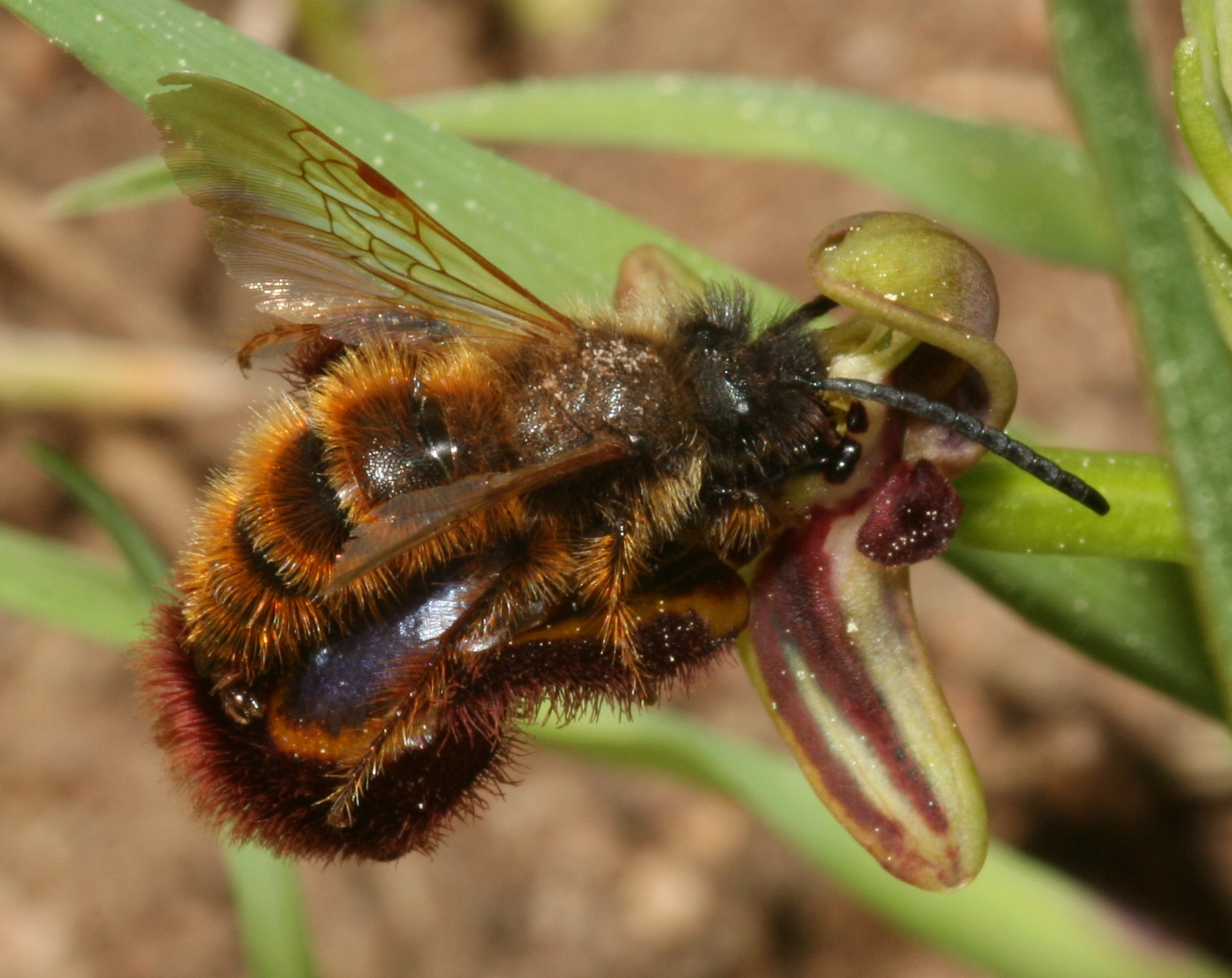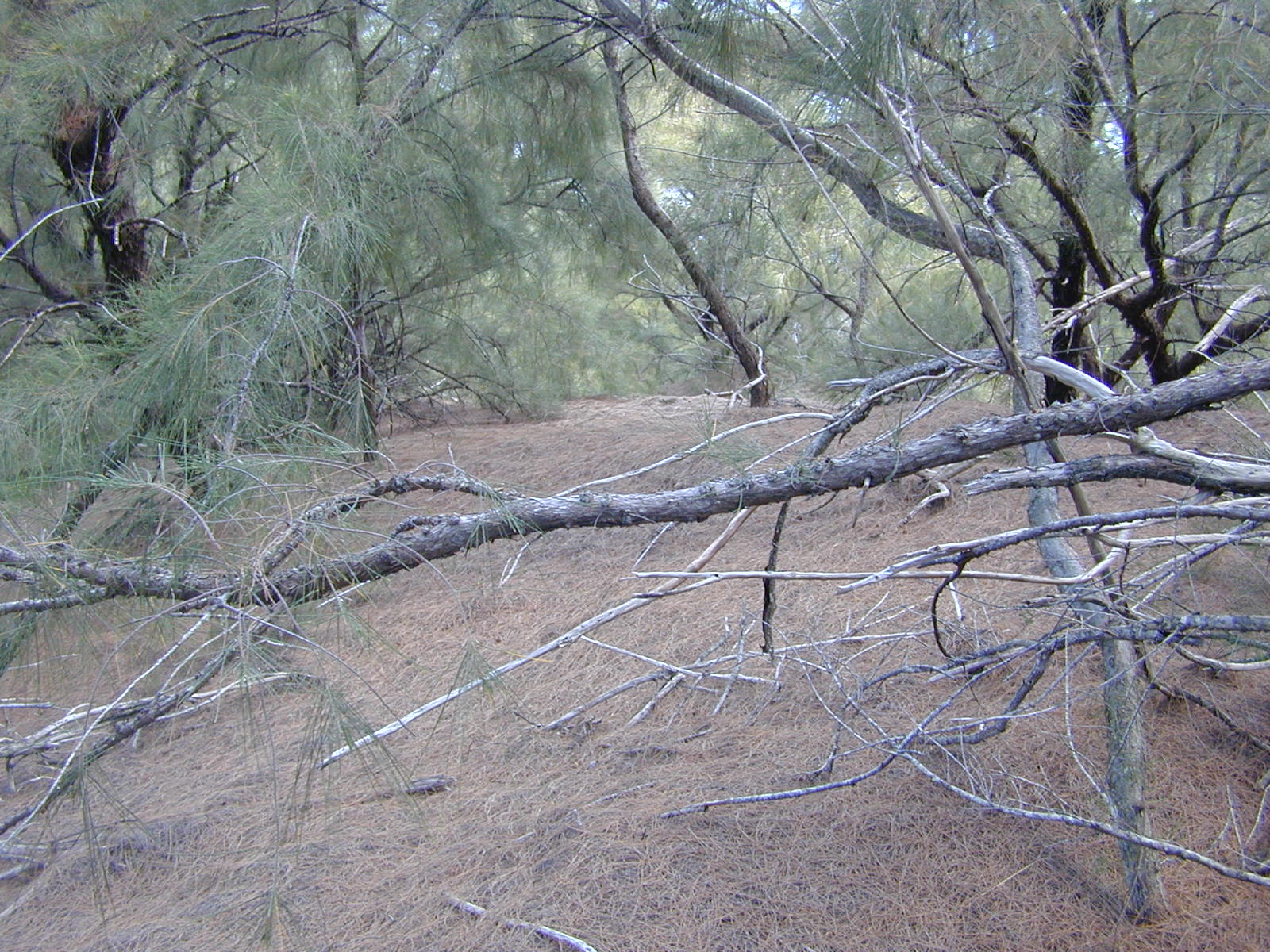|
Allomone
An allomone (from Ancient Greek ' "other" and pheromone) is a type of semiochemical produced and released by an individual of one species that affects the behaviour of a member of another species to the benefit of the originator but not the receiver. Production of allomones is a common form of defense against predators, particularly by plant species against insect herbivores. In addition to defense, allomones are also used by organisms to obtain their prey or to hinder any surrounding competitors. Many insects have developed ways to defend against these plant defenses (in an evolutionary arms race). One method of adapting to allomones is to develop a positive reaction to them; the allomone then becomes a kairomone. Others alter the allomones to form pheromones or other hormones, and yet others adopt them into their own defensive strategies, for example by regurgitating them when attacked by an insectivorous insect. A third class of allelochemical (chemical used in interspe ... [...More Info...] [...Related Items...] OR: [Wikipedia] [Google] [Baidu] |
Synomone
A semiochemical, from the Greek σημεῖον (''semeion''), meaning "signal", is a chemical substance or mixture released by an organism that affects the behaviors of other individuals. Semiochemical communication can be divided into two broad classes: communication between individuals of the same species (intraspecific) or communication between different species ( interspecific). It is usually used in the field of chemical ecology to encompass pheromones, allomones, kairomones, attractants and repellents. Many insects, including parasitic insects, use semiochemicals. Pheromones are intraspecific signals that aid in finding mates, food and habitat resources, warning of enemies, and avoiding competition. Interspecific signals known as allomones and kairomones have similar functions. In nature Pheromone A pheromone (from Greek ''phero'' "to bear" + ''hormone'' from Greek – "impetus") is a secreted or excreted chemical factor that triggers a social response in members o ... [...More Info...] [...Related Items...] OR: [Wikipedia] [Google] [Baidu] |
Semiochemical
A semiochemical, from the Greek wiktionary:σημεῖον, σημεῖον (''semeion''), meaning "signal", is a chemical substance or mixture released by an organism that affects the behaviors of other individuals. Semiochemical communication can be divided into two broad classes: communication between individuals of the same species (intraspecific) or communication between different species (Interspecies communication, interspecific). It is usually used in the field of chemical ecology to encompass pheromones, allomones, kairomones, attractants and Animal repellent, repellents. Many insects, including Parasitoid#Parasitoidal insects, parasitic insects, use semiochemicals. Pheromones are intraspecific signals that aid in finding mates, food and habitat resources, warning of enemies, and avoiding competition. Interspecific signals known as allomones and kairomones have similar functions. In nature Pheromone A pheromone (from Greek ''phero'' "to bear" + ''hormone'' from Gree ... [...More Info...] [...Related Items...] OR: [Wikipedia] [Google] [Baidu] |
Kairomone
A kairomone is a semiochemical released by an organism that mediates interspecific interactions in a way that benefits a different species at the expense of the emitter. Derived from the Greek καιρός, meaning "''opportune moment""kairomone, n.". OED Online. September 2012. Oxford University Press. http://www.oed.com/view/Entry/241005?redirectedFrom=kairomone (accessed 3 October 2012).'', it serves as a form of "eavesdropping", enabling the receiver to gain an advantage, such as locating food or evading predators, even if it poses a risk to the emitter. Unlike allomones, which benefit the producer at the receiver's cost, or synomones, which are mutually beneficial, kairomones favor only the recipient. Primarily studied in entomology, kairomones can play key roles in predator-prey dynamics, mate attraction, and even applications in pest control. Predator detection and prey localization An example of this can be found in the Ponderosa Pine tree (''Pinus ponderosa''), which ... [...More Info...] [...Related Items...] OR: [Wikipedia] [Google] [Baidu] |
Desmodium
''Desmodium'' is a genus of plants in the legume family Fabaceae, sometimes called tick-trefoil, tick clover, hitch hikers or beggar lice. There are dozens of species and the delimitation of the genus has shifted much over time. Species are distributed widely – from Quebec to northern Argentina in the Americas, across northern and southern tropical Africa, in the southern Arabian Peninsula, in Myanmar and Thailand, New Guinea, and northern and eastern Australia. Description These are mostly inconspicuous plants; few have bright or large flowers. Though some can become sizeable plants, most are herbs or small shrubs. Their fruit are loments, meaning each seed is dispersed individually enclosed in its segment. This makes them tenacious plants and some species are considered weeds in places. Uses Several ''Desmodium'' species release organic compounds, aerially and into the soil, which make them useful for agriculture: Allelopathic compounds are used there via push-pull tech ... [...More Info...] [...Related Items...] OR: [Wikipedia] [Google] [Baidu] |
Chemical Mimicry
Chemical mimicry (or molecular mimicry) is a type of biological mimicry involving the use of chemicals to dupe an operator. A chemical mimic dupes an operator (e.g. a predator) by showing an adaptive chemical resemblance to an object of its environment and as a consequence receives selective advantage. In all cases of chemical mimicry it has been found that the mimicking species is the only species to benefit from the reaction with either costs or no effect on the duped species. This is by adapting to produce chemicals (ex: allomones, pheromones, Odor, odours, etc.) that will cause a desirable behavioural reaction in the species being deceived and a selective advantage to the mimic, as in ant mimicry. Chemical mimicry exists within many of the different forms of mimicry such as Aggressive mimicry, aggressive, protective, Batesian mimicry , Batesian, and Müllerian mimicry and can involve a number of different senses. Mimicking semiochemicals make up some of the most widely use ... [...More Info...] [...Related Items...] OR: [Wikipedia] [Google] [Baidu] |
Bark Beetle
A bark beetle is the common name for the subfamily of beetles Scolytinae. Previously, this was considered a distinct family (Scolytidae), but is now understood to be a specialized clade of the "true weevil" family (Curculionidae). Although the term "bark beetle" refers to the fact that many species feed in the inner bark (phloem) layer of trees, the subfamily also has many species with other lifestyles, including some that bore into wood, feed in fruit and seeds, or tunnel into herbaceous plants. Well-known species are members of the type genus '' Scolytus'', namely the European elm bark beetle ''S. multistriatus'' and the large elm bark beetle ''S. scolytus'', which like the American elm bark beetle '' Hylurgopinus rufipes'', transmit Dutch elm disease fungi (''Ophiostoma''). The mountain pine beetle ''Dendroctonus ponderosae'', southern pine beetle '' Dendroctonus frontalis'', and their near relatives are major pests of conifer forests in North America. A similarly aggres ... [...More Info...] [...Related Items...] OR: [Wikipedia] [Google] [Baidu] |
Lomamyia Latipennis
''Lomamyia'' is a genus of beaded lacewings in the family Berothidae. There are about 11 described species in ''Lomamyia''. Biology Larvae of ''Lomamyia'' are predatory upon termites, and they have been shown to incapacitate their prey using a chemical sprayed from their anus. Species These 11 species belong to the genus ''Lomamyia'': * '' Lomamyia banksi'' Carpenter, 1940 * '' Lomamyia flavicornis'' (Walker, 1853) * '' Lomamyia fulva'' Carpenter, 1940 * '' Lomamyia hamata'' (Walker, 1853) * '' Lomamyia latipennis'' Carpenter, 1940 * '' Lomamyia longicollis'' (Walker, 1853) * '' Lomamyia occidentalis'' (Banks in Baker, 1905) * '' Lomamyia squamosa'' Carpenter, 1940 * '' Lomamyia tenuis'' Carpenter, 1940 * '' Lomamyia texana'' (Banks, 1897) * '' Lomamyia trombetensis'' Penny, 1985 References Further reading * * * * Hemerobiiformia Neuroptera genera {{neuroptera-stub ... [...More Info...] [...Related Items...] OR: [Wikipedia] [Google] [Baidu] |
Dasyscolia Ciliata
''Dasyscolia ciliata'' is a species of scoliid wasp found throughout the Mediterranean. It is the only species in the genus ''Dasyscolia''. It is the only known pollinator of the European ''Ophrys speculum''. The male wasp is tricked into pollinating the ''Ophrys'' orchid via pseudocopulation. The orchid's Pouyannian mimicry has the flower effectively mimicking the female wasp in appearance and scent. References External links * Dasyscolia ciliata – Encyclopedia of Life Scoliidae Orchid pollinators Insects described in 1787 Monotypic Hymenoptera genera {{Apocrita-stub ... [...More Info...] [...Related Items...] OR: [Wikipedia] [Google] [Baidu] |
Chemical Ecology
A chemical substance is a unique form of matter with constant chemical composition and characteristic properties. Chemical substances may take the form of a single element or chemical compounds. If two or more chemical substances can be combined without reacting, they may form a chemical mixture. If a mixture is separated to isolate one chemical substance to a desired degree, the resulting substance is said to be chemically pure. Chemical substances can exist in several different physical states or phases (e.g. solids, liquids, gases, or plasma) without changing their chemical composition. Substances transition between these phases of matter in response to changes in temperature or pressure. Some chemical substances can be combined or converted into new substances by means of chemical reactions. Chemicals that do not possess this ability are said to be inert. Pure water is an example of a chemical substance, with a constant composition of two hydrogen atoms bonded to ... [...More Info...] [...Related Items...] OR: [Wikipedia] [Google] [Baidu] |
Behavioral Ecology
Behavioral ecology, also spelled behavioural ecology, is the study of the evolutionary basis for ethology, animal behavior due to ecology, ecological pressures. Behavioral ecology emerged from ethology after Niko Tinbergen outlined Tinbergen's four questions, four questions to address when studying animal behaviors: what are the proximate causes, ontogeny, Adaption, survival value, and phylogeny of a behavior? If an organism has a trait that provides a selective advantage (i.e., has adaptive significance) in its environment, then natural selection favors it. Adaptive significance refers to the expression of a trait that affects fitness, measured by an individual's reproductive success. Adaptive traits are those that produce more copies of the individual's genes in future generations. Maladaptive traits are those that leave fewer. For example, if a bird that can call more loudly attracts more mates, then a loud call is an adaptive trait for that species because a louder bird mates ... [...More Info...] [...Related Items...] OR: [Wikipedia] [Google] [Baidu] |
Allelopathy
Allelopathy is a biological phenomenon by which an organism produces one or more biochemicals that influence the germination, growth, survival, and reproduction of other organisms. These biochemicals are known as allelochemicals and can have beneficial (positive allelopathy) or detrimental (negative allelopathy) effects on the target organisms and the community. Allelopathy is often used narrowly to describe chemically-mediated competition between plants; however, it is sometimes defined more broadly as chemically-mediated competition between any type of organisms. The original concept developed by Hans Molisch in 1937 seemed focused only on interactions between plants, between microorganisms and between microorganisms and plants. Allelochemicals are a subset of secondary metabolites, which are not directly required for metabolism (i.e. growth, development and reproduction) of the allelopathic organism. Allelopathic interactions are an important factor in determining species dis ... [...More Info...] [...Related Items...] OR: [Wikipedia] [Google] [Baidu] |
Cockroach
Cockroaches (or roaches) are insects belonging to the Order (biology), order Blattodea (Blattaria). About 30 cockroach species out of 4,600 are associated with human habitats. Some species are well-known Pest (organism), pests. Modern cockroaches are an ancient group that first appeared during the Late Jurassic, with their ancestors, known as "Roachoid, roachoids", likely originating during the Carboniferous period around 320 million years ago. Those early ancestors, however, lacked the internal ovipositors of modern roaches. Cockroaches are somewhat generalized insects lacking special adaptations (such as the sucking Insect mouthparts, mouthparts of aphids and other Hemiptera, true bugs); they have chewing mouthparts and are probably among the most primitive of living Neopteran insects. They are common and hardy insects capable of tolerating a wide range of Köppen climate classification, climates, from Arctic cold to Tropics, tropical heat. Tropical cockroaches are often muc ... [...More Info...] [...Related Items...] OR: [Wikipedia] [Google] [Baidu] |





